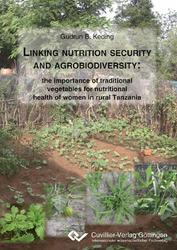| Fachbereiche | |
|---|---|
| Buchreihen (96) |
1378
|
| Nachhaltigkeit |
3
|
| Gesundheitswesen |
1
|
| Geisteswissenschaften |
2363
|
| Naturwissenschaften |
5406
|
| Mathematik | 229 |
| Informatik | 319 |
| Physik | 980 |
| Chemie | 1363 |
| Geowissenschaften | 131 |
| Humanmedizin | 243 |
| Zahn-, Mund- und Kieferheilkunde | 10 |
| Veterinärmedizin | 108 |
| Pharmazie | 147 |
| Biologie | 835 |
| Biochemie, Molekularbiologie, Gentechnologie | 121 |
| Biophysik | 25 |
| Ernährungs- und Haushaltswissenschaften | 45 |
| Land- und Agrarwissenschaften | 1004 |
| Forstwissenschaften | 201 |
| Gartenbauwissenschaft | 20 |
| Umweltforschung, Ökologie und Landespflege | 148 |
| Ingenieurwissenschaften |
1791
|
| Allgemein |
98
|
|
Leitlinien Unfallchirurgie
5. Auflage bestellen |
|
Erweiterte Suche
Linking nutrition security and agrobiodiversity: the importance of traditional vegetables for nutritional health of women in rural Tanzania
Gudrun B. Keding (Autor)Vorschau
Inhaltsverzeichnis, Datei (28 KB)
Leseprobe, Datei (77 KB)
This cross-sectional sequential study investigated the link between vegetable diversity available
(“production”) and dietary diversity of women (“consumption”) in three different districts of rural
Tanzania. Furthermore, the relationship between the nutritional health status of participants and
cropping and dietary diversity was analysed.
The study was carried out during three different seasons within one year (2006/2007) in 18
villages of three districts in north-eastern and central Tanzania including 252 women. The survey
included an individual interview on vegetable production, food consumption (i.a. 24h-recall, 7drecall
on vegetables) and nutritional knowledge, and the measurement of body mass index (BMI),
haemoglobin (Hb) for iron status and different parameters for vitamin A status. Besides studying
single nutrients, food groups and health problems, also a more holistic view was taken on dietary
diversity/food variety and dietary patterns and their relationships with nutritional status and
vegetable production. Relationships were investigated both through bivariate correlations and
multiple regression analysis; dietary diversity and food variety scores were calculated and dietary
patterns were generated through principal component analysis (PCA) as well as cluster analysis.
Regarding the link between production and consumption, there was a clear relationship between
vegetable diversity produced and diversity consumed, while this was not so clear between
production and consumption quantity, except for single seasons. Influencing factors on consumed
vegetable quantity were suggested to be seasonality; the purchase of additional vegetables
(especially exotic) next to home-grown ones; and knowledge, attitudes and preferences of women
regarding vegetable consumption. When analysing food patterns, no direct association between
diversity of vegetable cropping and vegetable consumption was established. Yet, for the study
population in Tanzania it was found that food consumption was (still) influenced by local
production and that, therefore, food consumption issues should always integrate existing food
production and vice versa.
The link established between food consumption and nutritional health data of the present study
showed that the obesity epidemic is on the rise, even in rural, poor and underdeveloped regions
of Tanzania. Furthermore, it was found that a high dietary diversity is not per se a guarantee for a
healthy diet, yet, food types and food groups that contribute to a high diversity are decisive. A
direct link between production and nutritional health could only partly be shown. Obviously, the
focus on vegetable production seems to be not sufficient, but overall food production needs to be
taken into account.
Further recommendations for future research are, i.a., to investigate the influence of exotic
vegetables and, generally, exotic foods in production and consumption on nutritional health; to
enhance dietary diversity scores as a tool for assessing dietary diversity together with dietary
quality; to eleborate dietary guidelines for Tanzania, preferably district- or area-wise; to investigate
the nutrition transition in Tanzania especially in rural areas with a focus on the nutritional
knowledge of people, their attitudes, preferences (e.g. taste) and behaviour
| ISBN-13 (Printausgabe) | 386955598X |
| ISBN-13 (Printausgabe) | 9783869555980 |
| ISBN-13 (E-Book) | 9783736935983 |
| Buchendformat | A5 |
| Sprache | Englisch |
| Seitenanzahl | 280 |
| Umschlagkaschierung | matt |
| Auflage | 1 Aufl. |
| Band | 0 |
| Erscheinungsort | Göttingen |
| Promotionsort | Universität Gießen |
| Erscheinungsdatum | 16.12.2010 |
| Allgemeine Einordnung | Dissertation |
| Fachbereiche |
Ernährungs- und Haushaltswissenschaften
Land- und Agrarwissenschaften |
| Schlagwörter | <a href="http://www.uni-giessen.de/cms/fbz/fb09/institute/ernaehrungswissenschaft/ag/krawinkel/ak/Keding/">Website der Autorin</a> |








